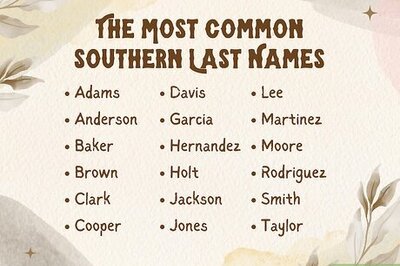
views
BRASILIA, Brazil: Thousands of Indigenous people marched toward Brazils Supreme Court on Wednesday to pressure justices expected to issue a ruling with far-reaching implications for land rights.
Wearing feather headdresses and with their bodies painted, they sang and danced along their 5-kilometer (3-mile) route. The group, which has been camping all week in the capital behind the National Theater, is comprised of some 6,000 people from 173 ethnic groups across the country, according to Association of Brazils Indigenous Peoples, a rights group and one of the organizers.
Justices will be evaluating a lower court’s ruling that invalidated a claim by some Indigenous people in Santa Catarina state to what they say is their ancestral territory. The lower court based its decision on allegations the group wasn’t occupying the land in October 1988, when Brazils constitution was signed after the nations return to democracy, which the group denies.
The Indigenous people were frustrated that the court didn’t start discussing the case Wednesday. The majority of justices have yet to vote on another contentious debate, regarding the constitutionality of the Brazilian central banks autonomy.
Protest organizers say the courts decision could be the ruling of the century, because negating the 1988 benchmark would force judges across the country to impose that understanding on similar pending cases, and also affect the fate of a related, controversial bill advancing in Congress.
President Jair Bolsonaro suggested Wednesday that overturning the lower court’s ruling would prompt new requests to officially recognize hundreds of Indigenous territories.
His attorney general filed a request to the country’s top court seeking to stop the Indigenous people from gathering, citing pandemic protocols that the president himself has repeatedly ignored. Justice Luis Roberto Barroso denied the request, saying he believed demonstrators were taking precautions.
Farming groups argue the 1988 cutoff date provides certainty regarding property law, but rights defenders say it ignores the fact many Indigenous people had been forcibly expelled from their lands, particularly during the military dictatorship, or may not have formal means to prove possession.
The criteria isnt functional for determining whether or not a territory was traditionally occupied because there are diverse contexts, diverse groups that for many reasons werent on their territories in 1988, said Samara Patax, a lawyer for the association.
Pi Surui, from the 7 de Setembro village in the Amazon rainforest state of Rondonia, said he had come to the capital to make clear that Indigenous territory is more than just land.
It is sacred, our history, our life, Surui, 23, said at the encampment. We have the right to grow our crops and sell our livestock, our fish, live sustainably. We are also adapting to the new times, balancing our needs and advances as human beings, but without losing our culture.
The Santa Catarina state government says the Indigenous people involved in the current court case invaded the land in 2009. The Xokleng people say the original extent of their territory was progressively diminished by encroaching agribusiness and that they never left the area.
Bolsonaro has repeatedly said Indigenous people control far too much land relative to their population their territories cover 14% of Brazil, most in the Amazon and has been outspoken about his desire to promote rural development.
Together with farm interests, he has argued that the 1988 cutoff had already been established by an earlier court ruling. Changing it now would create chaos, he said in a television interview on Wednesday.
If that happens, we will immediately have in front of us hundreds of new (Indigenous) areas to be demarcated, he told farming-focused station Canal Rural. In addition to the losses for the rural producer many have family occupying that land for more than 100 years those lands that today are productive could cease to be productive.
Some of the people marching on Wednesday held banners that read Bolsonaro Out and “Indigenous territory is life.
Jos Miguel Vivanco, executive secretary of Human Rights Watch for the Americas, took to Twitter to oppose the cutoff date, which he said large landholders and Bolsonaro allies are supporting in order to expel Indigenous people.
Brazilian supermodel Gisele Bndchen, who often advocates for Indigenous and environmental causes, also spoke out against it on social media.
Separately, the lower house of Congresss Constitution and Justice Committee in June approved a bill that would officially establish Oct. 1988 as the reference date for Indigenous people seeking full protection of their territories to have been occupying the land. There are more than 200 such pending requests, mostly for small territories located outside the Amazon rainforest. The bill is awaiting a floor vote.
A court ruling upholding the 1988 date would add legal backing to that bill in Congress, said Patax, the lawyer. If the court strikes down the prior ruling, that would weaken the bills momentum by providing justification to challenge its constitutionality in the future.
Brazil has 421 officially recognized Indigenous territories that are home to 466,000 people, according to the nonprofit Socioenvironmental Institute.
At a Tuesday night vigil ahead of Wednesday’s march, Indigenous people held lights and carried banners, one of which read: Our history doesn’t begin in 1988. We have resisted for more than 12,000 years. ___ Associated Press writer Debora Alvares reported this story in Brasilia and AP writer David Biller reported from Rio de Janeiro.
Disclaimer: This post has been auto-published from an agency feed without any modifications to the text and has not been reviewed by an editor
Read all the Latest News, Breaking News and Assembly Elections Live Updates here.




















Comments
0 comment